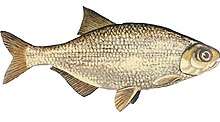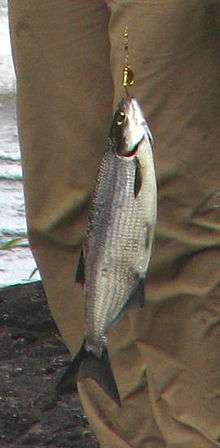Mooneye
The mooneyes, or Hiodontidae, are a family of ray-finned fish comprising two living and three extinct[1] species in the genus Hiodon. They are large-eyed, fork-tailed fish that physically resemble shads. Their common name comes from the metallic gold or silver shine of their eyes.
| Mooneyes | |
|---|---|
 | |
| Hiodon tergisus | |
| Scientific classification | |
| Kingdom: | Animalia |
| Phylum: | Chordata |
| Class: | Actinopterygii |
| Order: | Hiodontiformes Taverne, 1979 |
| Family: | Hiodontidae Cuvier & Valenciennes, 1846 |
| Genus: | Hiodon Lesueur, 1818 |
| Species | |
| |
| Synonyms | |
|
Eohiodon Cavender, 1966[1] | |
The higher classification of the mooneyes is not yet fully established. Some sources (as this one) place them in their own order, Hiodontiformes, while others retain them in the order Osteoglossiformes.
Hiodon tergisus

The mooneye (Hiodon tergisus Lesueur, 1818) is widespread across North America, living in the clear waters of lakes, ponds, and rivers. It consumes aquatic invertebrates, insects, and fish. Mooneyes can reach 47 centimetres (19 in) in length.
Mooneyes feed readily on terrestrial insects, and will provide fine sport for an intrepid fly-rod angler. They will also take small lures and natural baits with gusto. Mooneyes are frantic, hyperactive fish, and their impressive leaps and passionate fighting style has earned them the nickname "freshwater tarpon".
Hiodon alosoides
The goldeye (Hiodon alosoides Rafinesque, 1819) is also widespread across North America, and is notable for a conspicuous golden iris in the eyes. It prefers turbid slower-moving waters of lakes and rivers, where it feeds on a wide variety of organisms including insects, crustaceans, small fish, and mollusks. The fish has been reported up to 52 centimetres (20 in) in length. The smoked meat is highly valued and sold as "Winnipeg goldeye".
References
- Hilton, E. J.; Grande, L. (2008). "Fossil Mooneyes (Teleostei: Hiodontiformes, Hiodontidae) from the Eocene of western North America, with a reassessment of their taxonomy". Geological Society, London, Special Publications. 295: 221–251. doi:10.1144/sp295.13.
- Berra, Tim M. (2001). Freshwater Fish Distribution. San Diego: Academic Press. ISBN 0-12-093156-7
- Froese, Rainer, and Daniel Pauly, eds. (2011). "Hiodontidae" in FishBase. June 2011 version.
- L. Guo-Qing and M. V. H. Wilson. An Eocene Species of Hiodon from Montana, Its Phylogenetic Relationships, and the Evolution of the Postcranial Skeleton in the Hiodontidae (Teleostei). Journal of Vertebrate Paleontology Vol. 14, No. 2 (Jun. 22, 1994), pp. 153–167
- E. S. Zyznar, F. B. Cross and J. A. C. Nicol. Uric Acid in the Tapetum Lucidum of Mooneyes Hiodon (Hiodontidae Teleostei). Proceedings of the Royal Society of London. Series B, Biological Sciences, Vol. 201, No. 1142 (Apr. 13, 1978), pp. 1–6.
- C. Katechis, P. Sakaris and E. R. Irwin. Population Demographics of Hiodon tergisus (Mooneye) in the Lower Tallapoosa River. Southeastern Naturalist, Vol. 6, No. 3 (2007), pp. 461–470
- R. Wallus and J. P. Buchanan. Contributions to the Reproductive Biology and Early Life Ecology of Mooneye in the Tennessee and Cumberland River. American Midland Naturalist. Vol. 122, No. 1 (Jul., 1989), pp. 204–207
- C. Glenn. Seasonal parasitic infections in mooneye, Hiodon tergisus (LeSueur), from the Assiniboine River. Canadian Journal of Zoology Vol: 58 Issue: 2 Pages: 252-257 Published: 1980